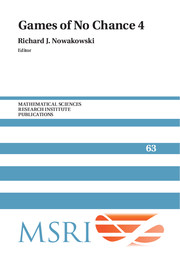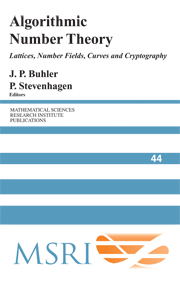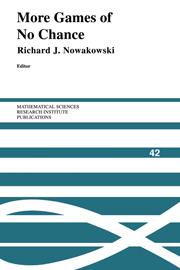Refine search
Actions for selected content:
48569 results in Computer Science
RSL volume 18 issue 2 Cover and Front matter
-
- Journal:
- The Review of Symbolic Logic / Volume 18 / Issue 2 / June 2025
- Published online by Cambridge University Press:
- 12 August 2025, pp. f1-f4
- Print publication:
- June 2025
-
- Article
-
- You have access
- Export citation
RSL volume 18 issue 2 Cover and Back matter
-
- Journal:
- The Review of Symbolic Logic / Volume 18 / Issue 2 / June 2025
- Published online by Cambridge University Press:
- 12 August 2025, pp. b1-b2
- Print publication:
- June 2025
-
- Article
-
- You have access
- Export citation

Games of No Chance 4
-
- Published online:
- 30 May 2025
- Print publication:
- 16 April 2015

Algorithmic Number Theory
- Lattices, Number Fields, Curves and Cryptography
-
- Published online:
- 30 May 2025
- Print publication:
- 20 October 2008
Tight Hamilton cycles with high discrepancy
- Part of
-
- Journal:
- Combinatorics, Probability and Computing / Volume 34 / Issue 4 / July 2025
- Published online by Cambridge University Press:
- 30 May 2025, pp. 565-584
-
- Article
-
- You have access
- Open access
- HTML
- Export citation

The Pi-Calculus
- A Theory of Mobile Processes
-
- Published online:
- 29 May 2025
- Print publication:
- 19 July 2001

More Games of No Chance
-
- Published online:
- 29 May 2025
- Print publication:
- 25 November 2002

Proof Complexity Generators
-
- Published online:
- 29 May 2025
- Print publication:
- 26 June 2025
Development and validation of an LMOOC Quality Evaluation Scale: A large-scale mixed-method approach
-
- Journal:
- ReCALL , First View
- Published online by Cambridge University Press:
- 29 May 2025, pp. 1-18
-
- Article
-
- You have access
- Open access
- HTML
- Export citation
Inquisitive split and structural completeness
-
- Journal:
- Mathematical Structures in Computer Science / Volume 35 / 2025
- Published online by Cambridge University Press:
- 29 May 2025, e12
-
- Article
- Export citation
Exception handling in multi-agent oriented programming
-
- Journal:
- The Knowledge Engineering Review / Volume 40 / 2025
- Published online by Cambridge University Press:
- 29 May 2025, e4
-
- Article
-
- You have access
- Open access
- HTML
- Export citation
Segmentation method of U-net sheet metal engineering drawing based on CBAM attention mechanism
-
- Article
-
- You have access
- Open access
- HTML
- Export citation
Voice-enabled human-robot interaction: adaptive self-learning systems for enhanced collaboration
-
- Article
-
- You have access
- Open access
- HTML
- Export citation
7 - Evaluation in Recommender Systems
-
- Book:
- Deep Learning Recommender Systems
- Published online:
- 08 May 2025
- Print publication:
- 22 May 2025, pp 225-247
-
- Chapter
- Export citation
3 - Top of the Tide
-
- Book:
- Deep Learning Recommender Systems
- Published online:
- 08 May 2025
- Print publication:
- 22 May 2025, pp 48-116
-
- Chapter
- Export citation
Afterword
-
- Book:
- Deep Learning Recommender Systems
- Published online:
- 08 May 2025
- Print publication:
- 22 May 2025, pp 291-291
-
- Chapter
- Export citation
8 - Frontier Practice of Deep Learning Recommender Systems
-
- Book:
- Deep Learning Recommender Systems
- Published online:
- 08 May 2025
- Print publication:
- 22 May 2025, pp 248-282
-
- Chapter
- Export citation
9 - Build Your Own Recommender Systems Knowledge Framework
-
- Book:
- Deep Learning Recommender Systems
- Published online:
- 08 May 2025
- Print publication:
- 22 May 2025, pp 283-290
-
- Chapter
- Export citation
















